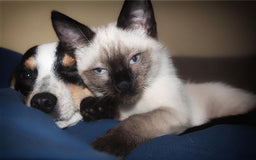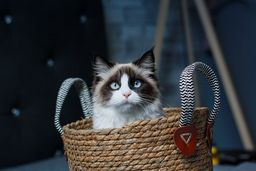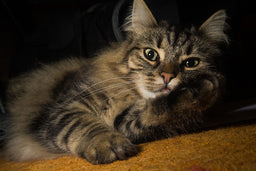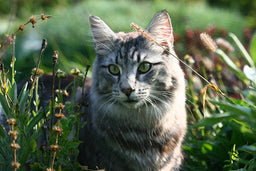The Siberian or Ragdoll cat—who to bring home? Resolving the dilemma!
Cats come in all shapes, sizes, and colours, but before adopting a feline companion, you must consider factors beyond appearance. If you’re into snuggly, fluffy kitties, the Siberian and Ragdoll cat breeds come up as top choices. Both are disarmingly charming and dedicated companions to their humans, but which one would complement your lifestyle?
Raising a kitty is a long-term commitment. The best way to pick between a Siberian and a Ragdoll cat would be to factor in their:
- Physical differences
- Individual temperament
- Lifestyle and engagement needs
- Hypoallergenic status
- General health
This article presents a thorough comparison to help you pick the perfect furry friend. We’ll also discuss your parental responsibilities and the nutritional requirements of keeping Ragdoll or Siberian cats fit and active.
Siberian cat vs Ragdoll cat—physical differences
Prospective adopters usually start with evaluating the size, weight, coat quality, and other physical aspects to determine if a kitty is suitable for their home.
The Siberian is one of the most ancient breeds in the world. These kitties sport a fluffy appearance similar to other natural breeds like the Maine Coon and Norwegian Forest Cat. Ragdolls were developed by selective breeding in the 1960s and are famous for their unique colourpoint coats and recognisable floppy physique.
Refer to the following table to learn about the distinctive physical traits of Ragdoll and Siberian cats:
|
Physical feature |
Siberian |
Ragdoll |
|
|
|
|
|
|
|
Coat quality |
|
|
|
Body type |
|
|
Ragdolls are massive kitties who need more indoor space and bigger beds than Siberian cats, which are significantly smaller.

Big cats can be fluffy, but it’s not always true the other way round.
Source: (left/right) Anna/umasiberian
Siberians vs Ragdolls—the difference in temperament
Siberian and Ragdoll cats are devoted to their families and adapt well to any household, but you’ll find subtle differences in their temperament. Let’s figure them out in detail:
|
Aspect |
Siberian |
Ragdoll |
|
Energy level and playfulness |
|
|
|
Indoor or outdoor preference |
|
|
|
Friendliness |
|
Friendly and affectionate to a fault with everyone, which makes them gullible to catnappers |
|
Trainability |
Easily trainable because of their:
|
Comparatively stubborn, especially as kittens, but positive words motivate them as they wish to impress humans |
|
Vocalisation |
Siberian kittens tend to be incessantly talkative but mellow down after sterilisation. They’re still more vocal than Ragdolls because they’re alert and expressive kitties |
|

True species intelligence is the way a Ragdoll strategises when their hooman plans a day out.
Source: champagneclarepark
Siberian or Ragdoll—the lifestyle preferences
Siberian cats have alpha personalities, making them suitable for people looking for fun and adventurous feline companions. Ragdolls are more beta in their attitude and suit those wanting gentle and relaxed apartment kitties. Keep in mind that these are general traits. Every cat is unique and might demonstrate various characteristics atypical for the breed. Their behaviour and attitude also depend on how you train and socialise them.
Here’s a comparative assessment of their common lifestyle preferences:
- Exercise—Since Siberian cats are highly athletic, they should ideally exercise for an hour each day. They are great climbers and love toys like cat towers. Ragdolls can stay fit with 20–30 minutes of exercise daily. They’re floor-dwellers with little interest in jumping and climbing, so they prefer interactive toys like lasers and catnip mice
- Grooming—Both breeds must be brushed once or twice a week to keep their coats free from tangles. While a Ragdoll adores grooming sessions, Siberians may act a bit restless during the ritual (easily fixed with treats!)
- Bonding—Ragdoll and Siberian cats are social and need to spend time with their human(s) every day (20 minutes at least, no upper limit). Ragdolls love following you around and are prone to anxiety and depression if often left alone for more than 8 hours. Siberian cats don’t mind being alone as they’re more self-assured and independent

Scenario—hooman gone for ten hours:
Siberian, “Looks like I run this place now.”
Ragdoll, “Hey flower, I’m probably being rude, but did you accidentally swallow my hooman?”
Source: (left/right) daJonas/Wunderland123
Are Siberian and Ragdoll cats hypoallergenic?
People with cat allergies react to the Fel d 1 protein found in a cat’s fur, saliva, sweat, dander, urine, and poo. All cats exude Fel d 1, but hypoallergenic kitties have a low concentration of allergens (because of their genetics).
Purebred Siberian cats are low-allergenic, so they are more suitable for homes with allergy sufferers. Ragdoll cats carry a regular amount of Fel d 1 in their bodies, so people with allergies should avoid them. Mixed breeds like the Siberian-Bengal or the Munchkin-Ragdoll are also not hypoallergenic.
Since no cat is non-allergenic, don’t adopt a kitty from a so-called hypoallergenic breed blindly. It’s prudent to test your sensitivity to a cat before you start caring for them. Talk to an allergy specialist if you want to raise a cat while suffering from moderate to severe allergies.
Who is healthier—the Siberian or Ragdoll cat?
Both breeds are prone to various health issues as they age, but Ragdolls have a slightly more promising lifespan than Siberian cats. With a healthy lifestyle and regular vet visits, a healthy Ragdoll can live for 15–20 years. Siberian kitties have a life expectancy of 10–15 years.
Despite the variance in lifespan, Siberian cats are usually more resilient than Ragdolls because of their genetic diversity. Ragdolls are heavily inbred, which leads to weaker immune systems and higher rates of genetic disorders. Here are some common feline conditions affecting these cat breeds:
|
Siberian |
Ragdoll |
|
|
Many of these health conditions (obesity, diabetes, gastrointestinal tract disorders, and urinary tract problems) are triggered by a poor dry-food diet. Buying kitty biscuits is the go-to option for many parents because it’s cheap, but they are far from the best food choice for cats because of their:
- Low moisture content—Dry food doesn’t provide enough moisture. Unless you regularly coax your cat to drink more water, their kidneys will be overworked, putting them at a high risk of developing renal and urinary tract diseases
- High carb and fat values—The natural feline diet includes whole meat that is high-protein, low-fat, and low-carb. Dry food tends to have higher than recommended carb and fat values because of:

You know what’s my superpower, hooman? Smelling tasteless fillers from miles away.
Source: awesome_franz
Save money on vet bills—invest in quality wet cat food
All cats should get their optimal everyday nutrition from wet food. Its high-moisture formula is ideal for maintaining digestive, renal, and urinary tract health. Wet food generally has a higher protein content than kibbles, so cats feel full and satisfied on smaller portions.
Wet food rejection is a common problem of cats addicted to kibble. Felines have strong survival instincts and often see sudden food changes as a threat, so you must be strategic when introducing a new product.
Keep in mind that not all canned goods are of the same quality, and pay attention to the ingredients:
- Whole meat —Cat food should have more than 50% animal protein, ideally from lean meat like chicken, tuna, turkey, and salmon. Avoid products with processed meat derivatives or vegan and dairy proteins because of their low biological value
- Fillers used—Common fillers in cat food include corn concentrate, vegetables, wheat, sweet potatoes, and green peas that significantly increase the carb content of the product. Most vets don’t recommend food with more than 3% carbs or 20% fats
- Artificial additives—Many manufacturers use harmful preservatives, colouring agents, flavour enhancers, and aroma additives to make the food long-lasting and more palatable, but such ingredients may cause food allergies or tummy upsets in felines
Let your kitty try Untamed!
Untamed is one of the most well-reviewed cat food brands in the UK, offering high-protein gravies and jellies made with 60%–63% whole meat. Whether you have a Siberian or a Ragdoll, our wet food will keep them happy and healthy.

The Untamed meal is hearty, scrumptious, and disappears without a trace!
Image (c) Untamed
Untamed will be your best investment in cat food because we:
- Offer human-grade whole meat—We use lean meat from the human supply chain as it's a better (and yummier) protein source than pet-grade items like bone digest and organ meals. We cooperate with ethical suppliers only, so our meat comes from cruelty-free farms and fish from dolphin-safe sources
- Ditch iffy fillers—Plant proteins, meat derivatives, dairy, sugar, and grains stay out of our meals
- Use formulas prepared by vets—We asked vets to tweak our recipes to make sure our food delivers essential micronutrients like taurine and B vitamins in appropriate ratios
- Steam our meals gently—Many nutrients lose their value when overcooked, so we simmer our food to keep the taste and goodness. Our succulent meals work perfectly for:
- Make allergen-free meals—We use hypoallergenic natural ingredients for cats with sensitive tummies and food allergies. Recuperating cats can try our light, single-protein-source meals like Tuck-in Tuna in Jelly and Chocka Chicken in Jelly
- Preserve the taste—Even finicky felines don’t reject Untamed because of the authentic aroma and flavour of the meat
Take our TRY NOW quiz and tell us about your furry friend’s health status and food preferences. You can create a tailor-made sample meal box and order it at the best rate!

Everything seems unfamiliar and scary to a new kitty. Make them feel at home with Untamed!
Image (c) Untamed
Ragdoll or Siberian, Untamed looks out for your kitty for life!
Our high-protein, grain-free meals are what kitties need at every life stage, so you don’t have to worry about changing products as your kitty grows. Here’s how Untamed helps:
- Kitten years—Kittens who start on Untamed hit all necessary growth milestones on time, including weight and muscle development. Our food stabilises their gastrointestinal health, so with controlled servings and an adequate meal schedule, they gradually adopt healthy eating habits (no pigging out!)
- Adulthood—Weight gain is a major concern for indoor Ragdoll and Siberian cats during adulthood. Untamed’s low-fat and low-carb recipes help them stay fit and ready for everyday adventures. Our food can help prevent diseases like hyperthyroidism, diabetes, constipation, arthritis, and IBS
- Senior years—Cats on Untamed won’t have a rough old age. They should be able to retain suitable weight and appetite, and they won’t become lazy or lethargic
Many cat parents have opted for our healthy cat food subscription for their feline friends. Here’s what they say about the benefits:
|
Timeline |
The Untamed effect! |
|
Week one |
|
|
Month two |
|
|
Month three |
|
|
Month six and up |
|

Untamed every day shoos the grumpiness away!
Image (c) Untamed
Get our trial pack so your kitty can explore our delicacies
As soon as you bring a new kitty home, gain their trust with the Untamed trial pack! Once you find what they like, you can get regular monthly deliveries of their favourite dishes!
To order our cat food online, follow these steps:
- Complete our short TRY NOW quiz
- Choose the products
- Place the order
We'll deliver the taster pack in a day with free shipping and in 100% recyclable packaging. You can use your Untamed account anytime to let us know if you wish to modify or cancel your order!
Tips for raising Siberian and Ragdoll kittens
If you brought home a Ragdoll or a Siberian kitten (or both—the more, the merrier!), focus on getting them acquainted with their surroundings and humans, in that order. Kittens of both breeds can be overwhelmed when they:
- Meet too many new people at once (especially Ragdolls)
- Find other pets already living in their new home
- Hear loud noises like heavy traffic and crying toddlers
A good strategy is introducing your kitty to their living space, litter box, and bed in their first week. Give them meals at regular intervals. Since Ragdoll and Siberian kittens mature slowly (it can take up to four years to achieve their adult weight), consult a vet about suitable serving sizes and a precise feeding schedule to prevent overfeeding.
Once your kitty feels secure in their home, introduce them to your kids and other pets. Kittenhood is also the time to teach your kitty manners like:
- Sitting still for regular dental brushing, nail clipping, and ear cleaning sessions
- Getting their monthly baths
- Not scratching and chewing household stuff (introduce them to chew toys and scratching posts instead)
Siberian and Ragdoll cat—who’s costlier?
Here’s how much each breed approximately costs:
|
Item |
Siberian |
Ragdoll |
|
Cost |
£450–£750 |
£800–£1,200 |
|
Vaccines |
£150–£500 |
£150–£500 |
|
Lifetime cost |
Upwards of £10,500 |
Upwards of £12,500 |
You may have to spend slightly more on monthly food supplies for Ragdolls since they’re large kitties and may need bigger serving sizes. Cat food should be portioned per kilo of your cat’s weight, irrespective of the breed. Typically, moderately active cats need about 40 to 45 calories per day for every kilo of their weight.
Besides food, you should also set a budget for potential vet visits down the line, which would vary according to the general health condition of the breed you pick.



